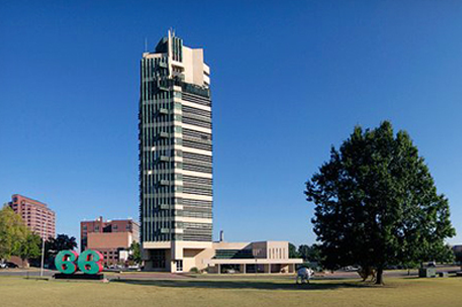Price Tower

The Price Tower is a nineteen story tower in Bartlesville, Oklahoma that was designed by Frank Lloyd Wright. It is the only realized skyscraper by Wright. The Price Tower was commissioned by Harold C. Price of the H. C. Price Company, a local oil pipeline and chemical firm. It opened to the public in February 1956.
Wright nicknamed the Price Tower, which was built on the Oklahoma prairie, “the tree that escaped the crowded forest,” referring not only to the building’s construction, but also to the origins of its design. The Price Tower is supported by a central “trunk” of four elevator shafts which are anchored in place by a deep central foundation, as a tree is by its taproot. The nineteen floors of the building are cantilevered from this central core, like the branches of a tree. The outer walls hang from the floors and are clad in patinated copper “leaves.” Wright had championed these design ideas, which other architects had put to use before the construction of the Price Tower, as early as the 1920s in his design for an apartment complex of four cantilevered towers for St. Marks-in-the-Bowerie in downtown New York City. Following the effects of the Great Depression, the project was shelved and adapted by Wright for the Price Company in 1952. Wright, therefore, plucked his “tree” out of the “crowded forest” of Manhattan skyscrapers and placed it on the Oklahoma prairie where it continues to stand uncrowded by neighboring tall buildings.
The floorplan of the Price Tower centers upon an inlaid cast bronze plaque, bearing the logo of the Price Company and marking the origin of a parallelogram grid upon which all exterior walls, interior partitions and doors, and built-in furniture are placed. The resulting design is a quadrant plan—one quadrant dedicated for double-height apartments, and three for offices. The materials for the Price Tower are equally innovative for a mid-twentieth-century skyscraper: cast concrete walls, pigmented concrete floors, aluminum-trimmed windows and doors, and patinated embossed and disstressed copper panels. The general geometric element is the equilateral triangle, and all lighting fixtures and ventilation grilles are based upon that form while the angled walls and built-in furniture are based on fractions or multiples of the triangular module. The lobby contains two inscriptions by Walt Whitman. One is from the concluding stanza of Salut au Monde, and the other from Song of the Broad-Axe.
(http://architectuul.com/architecture/price-tower)


